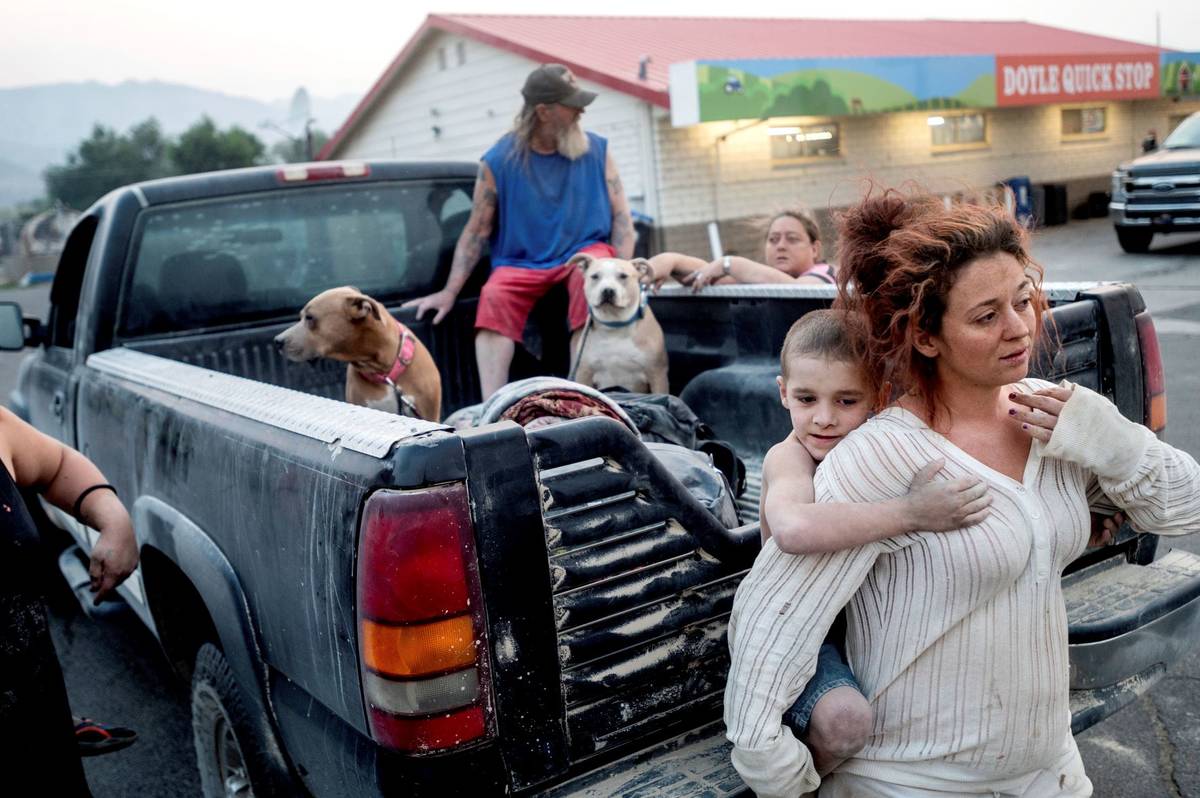Wildfires marching through Northern California
GRIZZLY FLATS, Calif. — Wind-driven wildfires raged Wednesday through drought-stricken forests in the mountains of Northern California after incinerating hundreds of homes and forcing thousands of people to flee to safety.
A reversal of wind direction was expected to test some previously quiet fire containment lines, but also push flames back in other areas, authorities said.
The newest inferno, the Caldor Fire, continued to grow explosively in the Sierra Nevada southwest of Lake Tahoe, covering 84 square miles after suddenly ravaging Grizzly Flats, a community of about 1,200.
At least 50 homes burned there but tallies were incomplete because officials had not been able to make thorough assessments of the damage in Grizzly Flats. Two people were hospitalized with serious injuries on Tuesday and about 5,900 homes and other structures were threatened by the fire.
In the Sierra-Cascades region about 100 miles to the north, the month-old Dixie Fire expanded by thousands of acres to 993 square miles — two weeks after the blaze gutted the Gold Rush-era town of Greenville. About 16,000 homes and buildings were threatened by the Dixie Fire, named for the road where it started.
“It’s a pretty good size monster,” Mark Brunton, a firefighting operations section chief, said in a briefing.
“We’re not going to get this thing overnight,” he said. “It’s going to be a work in progress — eating the elephant one bite at a time kind of thing — and it’s going to be a long-haul mindset. It’s a marathon and not a sprint.”
Northern California hit hard
The Caldor and Dixie fires are among a dozen large wildfires in the northern half of California. In contrast, Southern California has had few wildfires recently. Very moist ocean air even ushered in occasional drizzle or light rain on Wednesday.
But Northern California’s wildfires have left scenes of utter devastation.
Few homes were left standing in Grizzly Flats, where streets were littered with downed power lines and poles. Houses were reduced to smoldering ash and twisted metal with only chimneys rising above the ruins. A post office and elementary school were destroyed.
Hulks of gutted vehicles littered the ruins and the skeletons of chairs stood in rows among the ashes of a church.
Derek Shaves, who fled Grizzly Flats late Monday, said he visited the next day, finding that his home and most of the houses in his neighborhood were gone.
“It’s a pile of ash,” he said. “Everybody on my block is a pile of ash and every block that I visited — but for five separate homes that were safe — was totally devastated.”
All 7,000 residents of the town of Pollock Pines on Tuesday were ordered to evacuate because of the fire.
To the north at the Dixie Fire, numerous firefighting resources were deployed into the area of Susanville, a city of about 18,000 a few miles from the northeastern edge of the blaze, where residents have been warned to be ready to evacuate.
Fire officials said early Wednesday that the fire did not push toward Susanville overnight, and that was one location where the switch in wind direction to the northeast could push flames back on themselves.
Blackouts arrive
Late Tuesday, Pacific Gas & Electric began shutting off power to as many as 51,000 customers in 18 Northern California counties to prevent wildfires for the first time since last year’s historically bad fire season.
The utility said the shutoffs were focused in the Sierra Nevada foothills, the North Coast, the northern Central Valley and the North San Francisco Bay mountains and could last into Wednesday afternoon.
The nation’s largest utility announced the blackouts as a precaution to prevent gusts from damaging power lines and sparking blazes.
PG&E has notified utility regulators that the Dixie fire may have been caused by trees falling into its power lines. The Dixie Fire began near the town of Paradise, which was devastated by a 2018 wildfire ignited by PG&E equipment during strong winds. Eighty-five people died.
The Dixie Fire is the largest of nearly 100 major wildfires burning across a dozen Western states, including Alaska. The wildfires, in large part, have been fueled by high temperatures, strong winds and dry weather.
Climate change has made the U.S. West warmer and drier in the past 30 years and will continue to make the weather more extreme and wildfires more destructive, according to scientists.


















